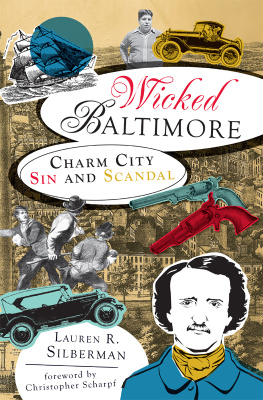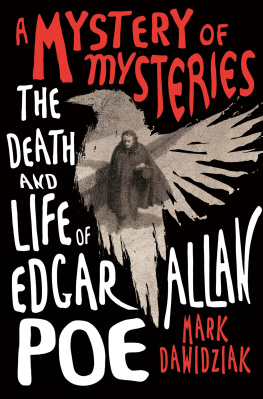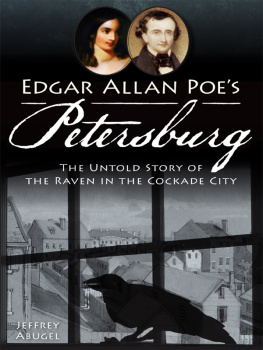
IMAGES
of America
EDGAR ALLAN POES
BALTIMORE

This emotive interpretation of Edgar Allan Poes burial monument by Anthony Washington confers a degree of silence and seclusion not possible in a daytime photograph. Here, the marble marker is marooned from the daily surge of animation. (Anthony Washington.)
ON THE COVER: From 1833 to 1835, this house at 203 North Amity Street in Baltimore was the residence of one of Americas greatest writers, Edgar Allan Poe. It was while living here that Poe was first paid for one of his compositions, marking the start of his professional literary career. The house has been designated a National Historic Landmark and today is visited annually by thousands from around the world. (Author.)
IMAGES
of America
EDGAR ALLAN POES
BALTIMORE
David F. Gaylin

Copyright 2015 by David F. Gaylin
ISBN 978-1-4671-2316-7
Ebook ISBN 9781439652107
Published by Arcadia Publishing
Charleston, South Carolina
Library of Congress Control Number: 2014950324
For all general information, please contact Arcadia Publishing:
Telephone 843-853-2070
Fax 843-853-0044
E-mail
For customer service and orders:
Toll-Free 1-888-313-2665
Visit us on the Internet at www.arcadiapublishing.com
To Anna Gaylin
Thine absence is the night.
CONTENTS
ACKNOWLEDGMENTS
Producing a book of images on a story that takes place largely before the invention of the photographic process presented a few challenges. Fortunately, many of the sites and structures associated with Poes Baltimore story survived into the photographic era and were duly captured for posterity; regrettably, many were not. For the latter, it became necessary to rely on drawings and engravings, particularly with personal portraits of those individuals who were integral to the narrative. This was only possible through access to immense archival resources, including the Enoch Pratt Free Library, Sheridan Libraries at Johns Hopkins University, Baltimore Sun Archives, and Maryland Historical Society, among others. With these assets, I enjoyed the assistance of many individuals, without whose guidance and knowledge I would have been lost.
I would like to thank the following people, to whom I am greatly indebted: Dr. Carla Hayden, Wesley Wilson, and Michael Johnson at the Enoch Pratt Free Library; Eben Dennis at the Maryland Historical Society; Zach Dixon at the Baltimore Sun Archives; Kate Wodehouse at the Providence Athenaeum; Jullianne Ballou at the University of Texas at Austin; Jim Stimpert at the Eisenhower Library at Johns Hopkins University; Chris Semtner, author and curator of the Museum of Edgar Allan Poe, who unselfishly gave his time, information, and images; Courtney Wilson and Jane Harper at the B&O Railroad Museum, for allowing access to the Poe Collection; Maureen Ottinger and Ritz Camera, for going above and beyond; Lisa Lewenz at the Edgar Allan Poe House, who forgave my many absences; and Gillian Nicol at Arcadia Publishing, for her expertise and patience. To Kristen Harbeson, who believed in the project from the very start and removed barriers along the way, go my deepest thankswithout her, this book simply could not have happened. Finally, I would like to express a special appreciation to eminent Poe scholar Jeffrey Savoye, who provided guidance, found critical photographs, and painstakingly reviewed the text to save me from many embarrassments.
Every effort was made by the author to ascertain the sources of the images shown and assign the correct attributions. For uniformity, photographs taken by the author and those in the authors collection as well as images in the public domain are simply credited Author.
INTRODUCTION
Whether or not one is an admirer of Edgar Allan Poe, most of us almost certainly have heard of him. What student has not read The Tell-Tale Heart? Here in Baltimore, there is no escape from the man. The city is dotted with sites associated with the great American poet and story writer: the food markets that nourished him and the brick towers that nourished his imagination; the train depots he used when he had money, and the streets he walked when he did not; the fine townhouses of his patrons and the spartan house where he not so much lived, but survived; the hospital building where he spent his last moments and his churchyard gravesite where many come to spend moments in reflection. And for those not given to visit the citys historical sites, the professional football team in Baltimore has been named after one of his poems.
Although Poe is inextricably linked to Baltimore, it should be said that this is just one of several US cities that are identified with him. He was born in Boston, Massachusetts, and his first book of poems, Tamerlane and Other Poems, was published there. During his literary career, he lived in Philadelphia longer than in any other city, from 1838 to 1844. While there, he wrote many of his more well-known works, including Murders in the Rue Morgue, The Pit and the Pendulum, and The Fall of the House of Usher. His most celebrated poemsThe Raven, Annabel Lee, and The Bellswere produced while he resided in New York City from 1844 to 1849. For a short period there, he realized his dream of becoming a magazine publisher. Richmond, Virginia, was the place of his youth. When Poe was only two, his mother died while working in that great city, leaving him and his siblings orphaned. Edgar was fostered by the family of a prosperous merchant there, John Allan, and received an exceptional education that included schooling in England and attendance at the newly created University of Virginia. Some who knew Poe said he had the accent and comportment of a Virginia gentleman.
Yet Baltimores affiliation with Edgar Allan Poe is arguably the strongest. His Irish ancestors settled in the port city during the 18th century and became prominent citizens. His grandfather was a hero of the American Revolution, and Poes father lived in the city for most of his life. When Poe fell out with his foster father, it was with his birth fathers family in Baltimore that he found a safe port in his stormy life. While living here from 1831 to 1835, he began writing short stories that were more marketable than his poetry. In 1833, he won recognition and a cash prize from the Baltimore Saturday Visiter for his tale MS. (Manuscript) Found in a Bottle. Poe had managed to get published before this time, mostly through his own devices, but it was while living in this city that he was first paid for one of his productions, marking the beginning of his professional literary career and Baltimore as the place of his discovery. After moving away from the city in 1835, he returned to visit many times and sustained relationships with the acquaintances he made here. Then, while passing through Baltimore in October 1849, he was stricken and died mysteriously, becoming a permanent resident. Each year, his Fayette Street burial site attracts thousands from around the world.
The Baltimore that Poe knew in the early part of the 19th century was the quintessential boomtown. The region north of the Patapsco River had been established in 1659 as Baltimore County, and, in 1729, a smaller area above the rivers north branch was designated by the state legislature for erecting a town. As recorded in an early directory, By this act Baltimore was to be a privileged place of landing, loading and selling, and exchanging goods. The following year, a surveyed plan was made, and the town began to grow at such a rate that, in a span of just 33 years, the nearby settlements of Jones Town and Fells Point had been absorbed.
Next page











